Concrete countertops have become increasingly popular for outdoor spaces due to their durability, versatility, and aesthetic appeal. This article will discuss everything you need to know about concrete countertops for outdoor use, from their benefits and design options to installation and maintenance. Whether you’re planning a new outdoor kitchen or updating your patio, concrete countertops can offer a unique and practical solution.
Benefits of Concrete Countertops for Outdoor Spaces
Durability and Longevity
Concrete countertops are renowned for their durability, making them an excellent choice for outdoor spaces. Unlike other materials, concrete can withstand various weather conditions, including extreme heat, cold, and moisture. This resilience ensures that your countertops will maintain their structural integrity and appearance for many years. Additionally, concrete is resistant to scratches and impacts, which is particularly beneficial for outdoor kitchens and dining areas where heavy use is expected.
Customization Options
One of the standout features of concrete countertops is their customization potential. Concrete can be molded into any shape, size, and thickness, allowing for a perfect fit in any outdoor space. You can choose from a wide range of colors, finishes, and textures to complement your outdoor decor. Integrating features like built-in sinks, cutting boards, and even embedded lighting is also possible, providing both functionality and aesthetic appeal.
Aesthetic Appeal
Concrete countertops offer a modern and sophisticated look that can elevate the aesthetic of any outdoor space. The material’s natural, earthy appearance blends well with outdoor environments, creating a seamless transition between your indoor and outdoor areas. Whether you prefer a polished, smooth surface or a more rustic, textured finish, concrete countertops can be tailored to match your design vision.

Eco-Friendly Option
For those concerned about environmental impact, concrete countertops are an eco-friendly choice. Concrete can be made from locally sourced materials, reducing transportation emissions. Additionally, it can incorporate recycled content, such as fly ash or slag cement, further minimizing its environmental footprint. The longevity of concrete countertops also means less frequent replacements, contributing to overall sustainability.
Heat and Fire Resistance
Concrete’s heat and fire-resistant properties make it ideal for outdoor kitchens. Unlike materials like laminate or wood, concrete can withstand high temperatures without scorching or warping. This makes it safe for use near grills, fire pits, and other cooking appliances commonly found in outdoor kitchens. The ability to endure direct sunlight without fading also ensures your countertops look great over time.
Low Maintenance
Maintaining concrete countertops is relatively straightforward, especially when they are properly sealed. Sealing helps to prevent staining and makes cleaning easier. Regular cleaning with mild soap and water is typically sufficient to keep them looking new. Unlike natural stone, concrete does not require frequent resealing or specialized cleaning products, making it a practical choice for busy households.
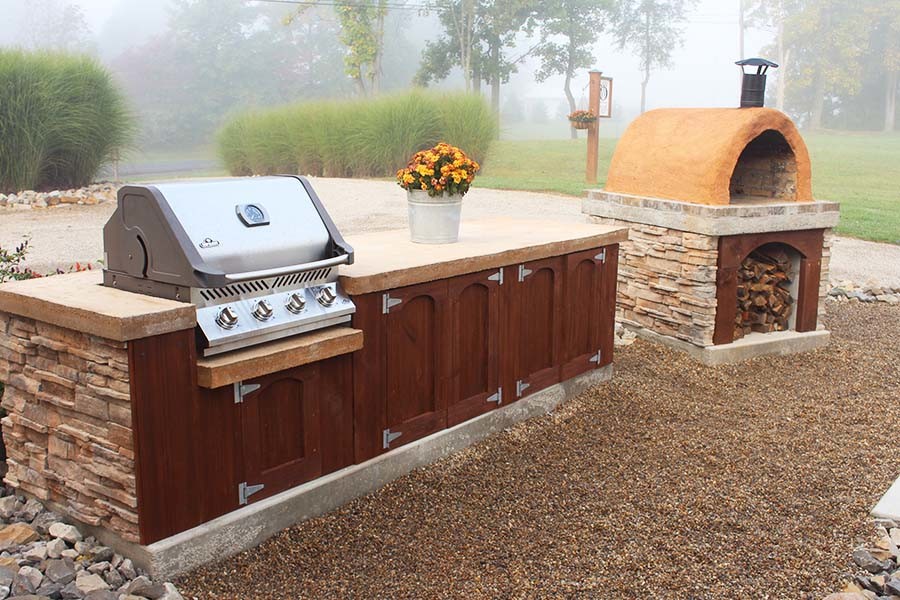
Designing Your Outdoor Concrete Countertops
Selecting the Right Style
When designing your outdoor concrete countertops, the first step is to select a style that complements your overall outdoor aesthetic. Whether you prefer a sleek, modern look or a more rustic, natural appearance, concrete can be customized to meet your preferences. Consider the existing elements in your outdoor space, such as furniture, flooring, and landscaping, to ensure a cohesive design.
Choosing Colors and Finishes
Concrete countertops offer a wide range of color and finish options. Integral pigments can be added to the concrete mix to achieve various shades, from subtle earth tones to vibrant hues. Stains and dyes can also be applied to the surface for additional color options. Finishes range from smooth and polished to textured and matte, each providing a different look and feel. Experimenting with different combinations can help you find the perfect match for your outdoor space.
Integrating Functional Features
Incorporating functional features into your concrete countertops can enhance their usability. Consider adding built-in sinks, drainboards, or cutting boards for added convenience. Integrating features like recessed trivets or embedded lighting can also enhance functionality while adding unique design elements. These customizations not only make your outdoor kitchen more efficient but also add a personalized touch.
Considering Edging and Details
The edges and details of your concrete countertops can significantly impact their overall look. Various edging styles, such as beveled, bullnose, or chiseled edges, can add a distinctive touch to your countertops. Inlays, such as decorative tiles, stones, or glass, can also be embedded into the surface for added visual interest. Paying attention to these small details can elevate the design and make your countertops stand out.
Planning for Weather Exposure
When designing outdoor concrete countertops, it’s crucial to consider their exposure to the elements. Selecting a high-quality sealer can help protect the surface from moisture, UV rays, and temperature fluctuations. Additionally, designing with overhangs or incorporating shading elements can help minimize direct exposure to harsh weather conditions, prolonging the lifespan of your countertops.
Budgeting for Your Project
Budgeting is a critical aspect of any design project. The cost of concrete countertops can vary based on factors such as size, complexity, and custom features. It’s essential to plan and allocate a budget that accommodates your design preferences and functional needs. Working with a professional can help you understand the costs involved and make informed decisions to achieve the best results within your budget.
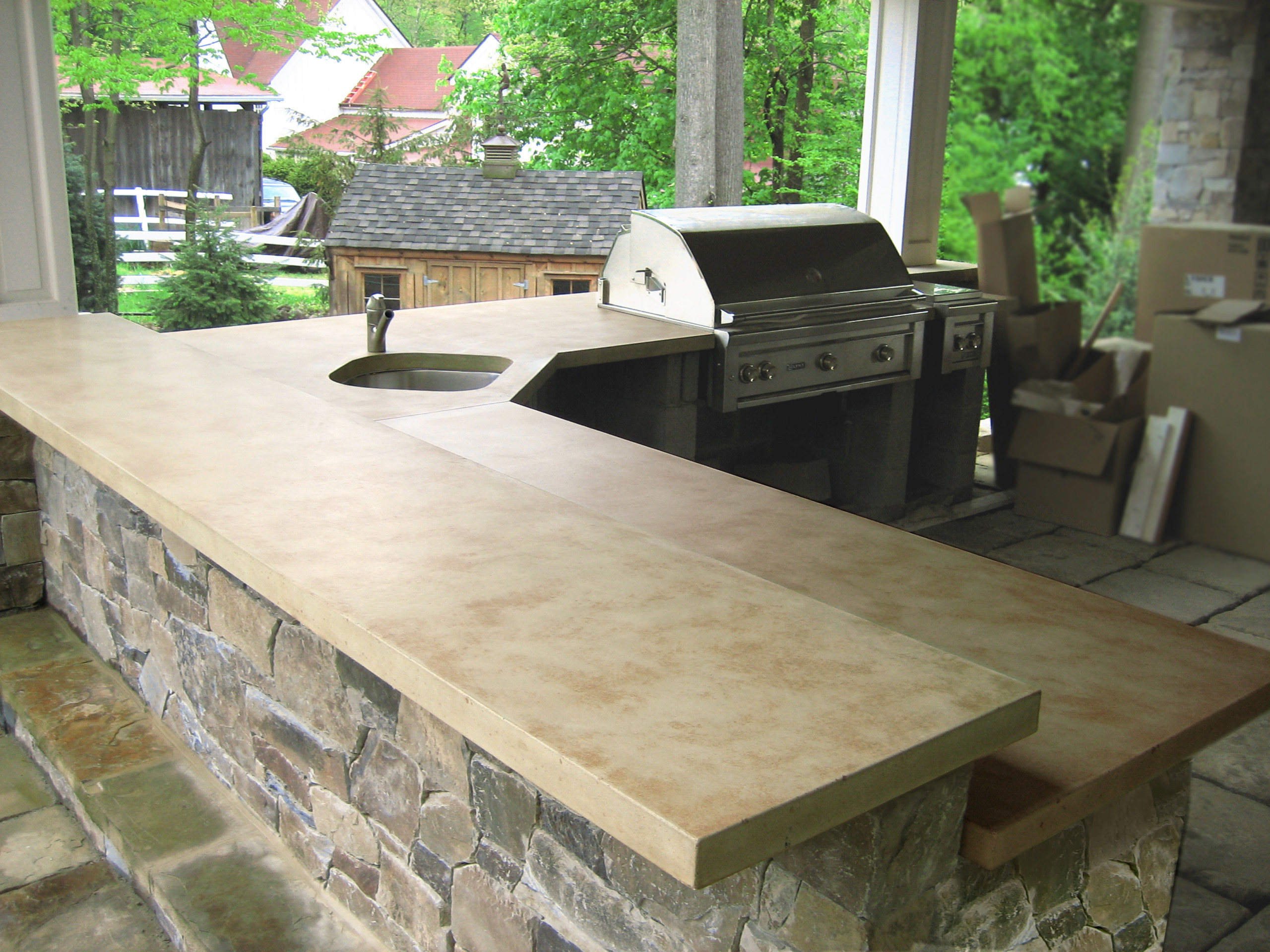
Installation Process
Preparing the Site
The first step in the installation process is preparing the site. This involves ensuring that the area where the countertops will be installed is level and structurally sound. Any existing structures or debris should be removed, and the base should be properly compacted. This preparation is crucial for ensuring the stability and longevity of the countertops.
Building the Forms
Forms are used to shape the concrete and create the desired countertop design. These forms are typically constructed from wood or foam and must be carefully built to match the specifications of the project. Attention to detail is essential to ensure that the forms are level and properly aligned. The forms must also be sturdy enough to hold the weight of the concrete without bowing or shifting.
Mixing and Pouring the Concrete
Once the forms are in place, the concrete is mixed according to the desired formula. This may involve adding pigments, aggregates, or other materials to achieve the desired color and texture. The concrete is then poured into the forms, ensuring that it is evenly distributed and free of air pockets. This step requires precision and care to ensure a smooth and consistent finish.
Finishing the Surface
After the concrete has been poured, the surface is smoothed and finished using various tools and techniques. This can include troweling to create a smooth surface or applying textures for a more rustic look. The finishing process may also involve adding decorative elements, such as inlays or stamps, to enhance the overall appearance of the countertops.
Curing and Sealing
Proper curing is essential for the strength and durability of concrete countertops. The curing process allows the concrete to harden and reach its full strength. This typically involves keeping the surface moist and protected from extreme temperatures for several days. Once the concrete has cured, a high-quality sealer is applied to protect the surface from stains, moisture, and UV damage.
Installing the Countertops
The final step in the installation process is placing the countertops in their designated location. This involves carefully removing the forms and transporting the countertops to the site. Proper handling and support are crucial to prevent cracking or damage. Once in place, the countertops are secured and any seams are filled to create a seamless look. Final adjustments and touch-ups ensure that the countertops are perfectly aligned and finished.

Maintenance and Care
Cleaning and Routine Maintenance
Regular cleaning is essential to keep your concrete countertops looking their best. A mild soap and water solution is typically sufficient for daily cleaning. Avoid using abrasive cleaners or harsh chemicals, as these can damage the sealer and surface of the concrete. Wiping up spills promptly can prevent staining and maintain the appearance of the countertops.
Sealing and Resealing
Sealing is crucial for protecting concrete countertops from stains, moisture, and UV damage. It’s recommended to reseal your countertops every 1-3 years, depending on usage and exposure to the elements. Regularly inspecting the sealant and applying additional coats as needed can help maintain the protective barrier and extend the life of your countertops.
Preventing and Repairing Stains
While sealed concrete is resistant to stains, it’s not completely impervious. Promptly cleaning up spills, especially acidic substances like vinegar or citrus, can prevent staining. If stains do occur, they can often be removed with a mixture of baking soda and water or a commercial concrete cleaner. For more stubborn stains, professional cleaning or resurfacing may be necessary.
Managing Cracks and Chips
Cracks and chips can occur in concrete countertops, especially in outdoor environments. Small hairline cracks are usually cosmetic and do not affect the structural integrity of the countertops. These can be filled with a color-matched concrete filler. For larger cracks or chips, professional repair may be required to restore the surface and prevent further damage.
Protecting from Weather Elements
Concrete countertops are designed to withstand outdoor conditions, but additional protection can help prolong their life. Using covers or awnings to shield the countertops from direct sunlight and heavy rain can prevent fading and weathering. During extreme weather conditions, such as freezing temperatures, it’s advisable to protect the countertops with a weatherproof cover to prevent cracking and other damage.
Seasonal Maintenance Tips
Different seasons bring varying weather conditions that can affect your concrete countertops. In the spring and summer, regular cleaning and sealing are essential to protect against UV damage and moisture. In the fall, removing leaves and debris can prevent staining and buildup. During winter, covering the countertops and avoiding the use of de-icing salts nearby can prevent cracking and surface damage.
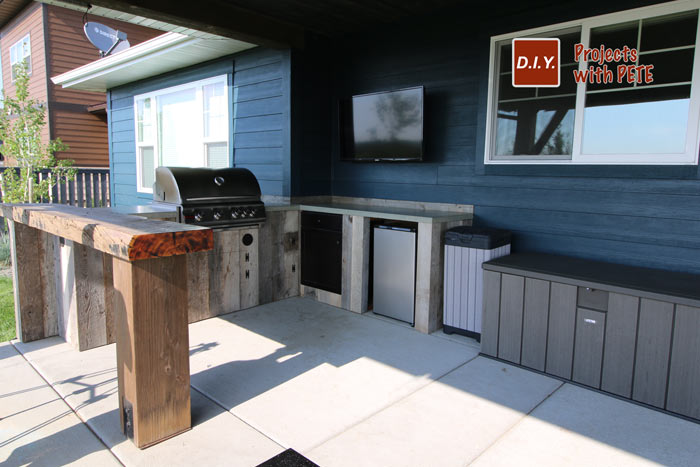
Enhancing Outdoor Living Spaces with Concrete Countertops
Outdoor Kitchens
Concrete countertops are a perfect addition to outdoor kitchens, offering a durable and attractive surface for food preparation and cooking. They can be customized to include built-in grills, sinks, and storage areas, creating a fully functional and aesthetically pleasing outdoor cooking space. The heat-resistant properties of concrete make it ideal for use near grills and other cooking appliances.
Patio and Dining Areas
Incorporating concrete countertops into patio and dining areas can enhance their functionality and appeal. Whether used as bar tops, dining tables, or serving stations, concrete provides a sturdy and stylish surface for entertaining guests. Its versatility in design allows for seamless integration with outdoor furniture and decor, creating a cohesive and inviting atmosphere.
Poolside Bars and Counters
For poolside bars and counters, concrete countertops offer a waterproof and weather-resistant solution. They can withstand splashes, spills, and exposure to chlorine without deteriorating. Additionally, concrete’s ability to be molded into various shapes and sizes makes it ideal for creating unique bar designs that complement the pool area and enhance the overall outdoor experience.
Fire Pit Surrounds
Concrete countertops can also be used to create elegant and functional surrounds for outdoor fire pits. The material’s heat resistance ensures safety and durability, while its customizable design options allow for creative and attractive fire pit designs. Whether for roasting marshmallows or enjoying a cozy evening by the fire, concrete surrounds provide a perfect blend of style and function.
Garden Workstations
For gardening enthusiasts, concrete countertops can serve as practical and durable workstations. They offer a sturdy surface for potting plants, arranging flowers, and performing other gardening tasks. The easy-to-clean nature of concrete makes it ideal for handling soil and water, while its weather-resistant properties ensure longevity and low maintenance.
Entertainment Areas
Concrete countertops can be incorporated into outdoor entertainment areas, providing versatile surfaces for various activities. From outdoor bars and serving stations to game tables and seating areas, concrete can be customized to meet the needs of any entertainment space. Its durability and design flexibility make it an excellent choice for creating stylish and functional outdoor environments.
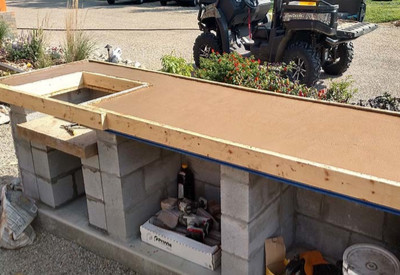
Common Mistakes to Avoid
Improper Sealing
One of the most common mistakes with concrete countertops is neglecting proper sealing. Failing to apply or maintain the sealant can lead to staining, moisture damage, and deterioration. It’s essential to use a high-quality sealer and follow the recommended application and reapplication schedule to protect the countertops from damage and extend their lifespan.
Ignoring Weather Protection
Another common mistake is not providing adequate weather protection for outdoor concrete countertops. While concrete is durable, prolonged exposure to extreme weather conditions can cause cracking, fading, and surface damage. Using covers, awnings, or other protective measures can help shield the countertops from harsh elements and prevent premature wear and tear.
Using Harsh Cleaners
Using abrasive or harsh chemical cleaners can damage the surface of concrete countertops and degrade the sealant. Stick to mild soap and water for routine cleaning and avoid products that contain acids or strong solvents. If a stronger cleaner is needed, choose one specifically designed for concrete surfaces to prevent damage.
Overlooking Structural Support
Concrete countertops are heavy and require proper structural support. Failing to ensure that the base or cabinetry beneath the countertops is strong enough to support the weight can lead to sagging, cracking, or even collapse. Consulting with a professional to verify the structural integrity of the installation site is crucial for safety and longevity.
Inadequate Mixing and Curing
Improper mixing and curing of concrete can result in weak or uneven countertops. It’s important to follow the correct mixing ratios and curing times to ensure the concrete reaches its full strength and durability. Skipping or rushing these steps can lead to a compromised surface that is prone to cracking and other issues.

How do I maintain my outdoor concrete countertops?
Maintaining outdoor concrete countertops involves regular cleaning with mild soap and water, promptly wiping up spills to prevent staining, and resealing every 1-3 years to protect against moisture and UV damage. During extreme weather conditions, using protective covers can help extend the lifespan of the countertops.
Can concrete countertops withstand extreme weather conditions?
Yes, concrete countertops are designed to withstand various weather conditions, including extreme heat, cold, and moisture. However, providing additional protection, such as using covers or awnings, can help minimize direct exposure to harsh elements and prolong the life of the countertops.
What are the customization options for concrete countertops?
Concrete countertops offer extensive customization options, including different shapes, sizes, colors, and finishes. You can choose from smooth or textured surfaces, various edging styles, and add decorative inlays or embedded features like sinks and lighting to create a unique and functional design.
How do I repair cracks in concrete countertops?
Small hairline cracks in concrete countertops can be filled with a color-matched concrete filler. For larger cracks or chips, professional repair may be necessary. It’s important to address cracks promptly to prevent further damage and maintain the structural integrity of the countertops.
Are concrete countertops an eco-friendly choice?
Yes, concrete countertops can be an eco-friendly option. They can be made from locally sourced materials and incorporate recycled content, reducing their environmental impact. Additionally, their durability and longevity mean less frequent replacements, contributing to overall sustainability.

What Is The Best Countertop For An Outdoor Kitchen?
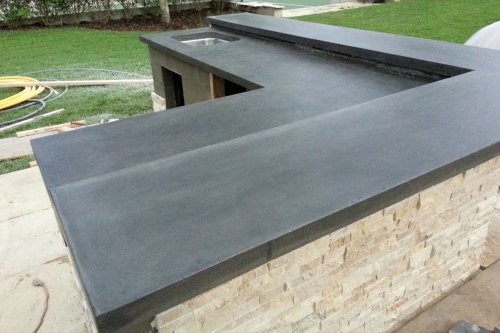
Related articles:
- Concrete Countertop Overlay
- Black Concrete Countertops
- Marble Look Concrete Countertops
- Light Grey Concrete Countertops
- Concrete Countertop Design Ideas
- Light Colored Concrete Countertops
- Epoxy On Concrete Countertop
- Concrete Countertops Designs
- Concrete Countertops That Look Like Wood
- White Concrete Countertops